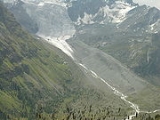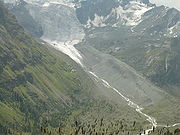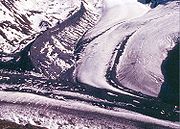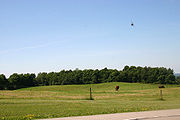
Moraine
Encyclopedia
A moraine is any glacially formed
accumulation of unconsolidated glacial debris (soil
and rock
) which can occur in currently glaciated and formerly glaciated regions, such as those areas acted upon by a past glacial maximum. This debris may have been plucked
off a valley
floor as a glacier
advanced or it may have fallen off the valley walls as a result of frost wedging or landslide. Moraines may be composed of debris ranging in size from silt
-sized glacial flour
to large boulders. The debris is typically sub-angular to rounded in shape. Moraines may be on the glacier’s surface or deposited as piles or sheets of debris where the glacier has melted. Moraines may also occur when glacier- or iceberg
-transported rocks fall into a body of water as the ice
melts.

s are defined by their particular morphology since their origin has been a matter of dispute. Some moraine types are only known from ancient glaciers, like the two former ones, while medial moraines of valley glaciers are poorly preserved and difficult to distinguish after the retreat or melting of the glacier.
is carried along the glacial margin until the glacier melts. Because lateral moraines are deposited on top of the glacier, they do not experience the postglacial erosion of the valley floor and therefore, as the glacier melts, lateral moraines are usually preserved as high ridges.
 Lateral moraines stand high because they protect the ice under them from the elements, which causes it to melt or sublime less than the uncovered parts of the glacier. Multiple lateral moraines may develop as the glacier advances and retreats.
Lateral moraines stand high because they protect the ice under them from the elements, which causes it to melt or sublime less than the uncovered parts of the glacier. Multiple lateral moraines may develop as the glacier advances and retreats.
 Ground moraines are till covered areas with irregular topography and no ridges, often forming gently rolling hills or plains. It is accumulated at the base of the ice as lodgment till, but may also be deposited as the glacier retreats. In alpine glaciers, ground moraines are often located between the two lateral moraines. Ground moraine may be modified into drumlins by the overriding ice.
Ground moraines are till covered areas with irregular topography and no ridges, often forming gently rolling hills or plains. It is accumulated at the base of the ice as lodgment till, but may also be deposited as the glacier retreats. In alpine glaciers, ground moraines are often located between the two lateral moraines. Ground moraine may be modified into drumlins by the overriding ice.
. The depressions between the ribs are sometimes filled with water making the Rogen moraines look like tigerstripe
s on aerial photographs. Rogen moraines are named after Lake Rogen in Härjedalen
, Sweden
, the landform’s type locality.
 End moraines, or terminal moraine
End moraines, or terminal moraine
s, are ridges of unconsolidated debris deposited at the snout or end of the glacier. They usually reflect the shape of the glacier's terminus
. Glaciers act much like a conveyor belt, carrying debris from the top of the glacier to the bottom where it deposits it in end moraines. End moraine size and shape is determined by whether the glacier is advancing, receding or at equilibrium. The longer the terminus of the glacier stays in one place the more debris will accumulate in the moraine. There are two types of end moraines; terminal and recessional. Terminal moraines mark the maximum advance of the glacier. Recessional moraines are small ridges left as a glacier pauses during its retreat. After a glacier retreats the end moraine may be destroyed by postglacial erosion.
, has a ridge of medial moraine 1 km wide.
, melting of surface ice or from debris that falls onto the glacier from valley sidewalls.
s, also known as minor or corrugated moraines, are low amplitude geomorphic features caused by glaciers. The name "washboard moraine" refers to the fact that, from the air, it resembles a washboard
.
and parts of Canada
.
Moraine examples
Glacial landforms
Glacial landforms are those created by the action of glaciers. Most of today's glacial landforms were created by the movement of large ice sheets during the Quaternary glaciations...
accumulation of unconsolidated glacial debris (soil
Soil
Soil is a natural body consisting of layers of mineral constituents of variable thicknesses, which differ from the parent materials in their morphological, physical, chemical, and mineralogical characteristics...
and rock
Rock (geology)
In geology, rock or stone is a naturally occurring solid aggregate of minerals and/or mineraloids.The Earth's outer solid layer, the lithosphere, is made of rock. In general rocks are of three types, namely, igneous, sedimentary, and metamorphic...
) which can occur in currently glaciated and formerly glaciated regions, such as those areas acted upon by a past glacial maximum. This debris may have been plucked
Plucking (glaciation)
Glacial plucking exploits pre-existing fractures in the bedrock. This plays a key role in opening and creating new fractures but has only provided small segments of loose material. This is then followed by the entrainment of the loosened rock by the ice. During the process of entrainment, loose...
off a valley
Valley
In geology, a valley or dale is a depression with predominant extent in one direction. A very deep river valley may be called a canyon or gorge.The terms U-shaped and V-shaped are descriptive terms of geography to characterize the form of valleys...
floor as a glacier
Glacier
A glacier is a large persistent body of ice that forms where the accumulation of snow exceeds its ablation over many years, often centuries. At least 0.1 km² in area and 50 m thick, but often much larger, a glacier slowly deforms and flows due to stresses induced by its weight...
advanced or it may have fallen off the valley walls as a result of frost wedging or landslide. Moraines may be composed of debris ranging in size from silt
Silt
Silt is granular material of a size somewhere between sand and clay whose mineral origin is quartz and feldspar. Silt may occur as a soil or as suspended sediment in a surface water body...
-sized glacial flour
Rock flour
Rock flour, or glacial flour, consists of fine-grained, silt-sized particles of rock, generated by mechanical grinding of bedrock by glacial erosion or by artificial grinding to a similar size...
to large boulders. The debris is typically sub-angular to rounded in shape. Moraines may be on the glacier’s surface or deposited as piles or sheets of debris where the glacier has melted. Moraines may also occur when glacier- or iceberg
Iceberg
An iceberg is a large piece of ice from freshwater that has broken off from a snow-formed glacier or ice shelf and is floating in open water. It may subsequently become frozen into pack ice...
-transported rocks fall into a body of water as the ice
Ice
Ice is water frozen into the solid state. Usually ice is the phase known as ice Ih, which is the most abundant of the varying solid phases on the Earth's surface. It can appear transparent or opaque bluish-white color, depending on the presence of impurities or air inclusions...
melts.

Types of moraines
Moraines can be classified either by their origin or shape. The first approach is suitable for moraines associated to contemporary glaciers but more difficult to apply to old moraines whose glaciers have disappeared long ago. Moraines types like rogen and veiki moraineVeiki moraine
A Veiki moraine is a particular type of moraine found in northern Sweden and parts of Canada that is characterized by forming a hummocky landscape of moraine plateaus with elevated rims that are intercalated with ponds. The name Veiki derives from the type locality of Veiki in Swedish Lapland...
s are defined by their particular morphology since their origin has been a matter of dispute. Some moraine types are only known from ancient glaciers, like the two former ones, while medial moraines of valley glaciers are poorly preserved and difficult to distinguish after the retreat or melting of the glacier.
Lateral moraines
Lateral moraines are parallel ridges of debris deposited along the sides of a glacier. The unconsolidated debris can be deposited on top of the glacier by frost shattering of the valley walls and/or from tributary streams flowing into the valley. The tillTill
thumb|right|Closeup of glacial till. Note that the larger grains in the till are completely surrounded by the matrix of finer material , and this characteristic, known as matrix support, is diagnostic of till....
is carried along the glacial margin until the glacier melts. Because lateral moraines are deposited on top of the glacier, they do not experience the postglacial erosion of the valley floor and therefore, as the glacier melts, lateral moraines are usually preserved as high ridges.

Ground moraines

Rogen moraines
Rogen moraines or ribbed moraines are a type of basal moraines that forms a series of ribs perpendicular to the ice flow in an ice sheetIce sheet
An ice sheet is a mass of glacier ice that covers surrounding terrain and is greater than 50,000 km² , thus also known as continental glacier...
. The depressions between the ribs are sometimes filled with water making the Rogen moraines look like tigerstripe
Tigerstripe
Tigerstripe is the name of a group of camouflage patterns developed for close-range use in dense jungle during jungle warfare by the South Vietnamese Armed Forces/US Forces. It derives its name from its resemblance to a tiger's stripes...
s on aerial photographs. Rogen moraines are named after Lake Rogen in Härjedalen
Härjedalen
' is a historical province or landskap in the centre of Sweden. It borders the country of Norway as well as the provinces of Dalarna, Hälsingland, Medelpad, and Jämtland...
, Sweden
Sweden
Sweden , officially the Kingdom of Sweden , is a Nordic country on the Scandinavian Peninsula in Northern Europe. Sweden borders with Norway and Finland and is connected to Denmark by a bridge-tunnel across the Öresund....
, the landform’s type locality.
End or terminal moraines

Terminal moraine
A terminal moraine, also called end moraine, is a moraine that forms at the end of the glacier called the snout.Terminal moraines mark the maximum advance of the glacier. An end moraine is at the present boundary of the glacier....
s, are ridges of unconsolidated debris deposited at the snout or end of the glacier. They usually reflect the shape of the glacier's terminus
Glacier terminus
A glacier terminus, or snout, is the end of a glacier at any given point in time. Although glaciers seem motionless to the observer, in reality glaciers are in endless motion and the glacier terminus is always either advancing or retreating...
. Glaciers act much like a conveyor belt, carrying debris from the top of the glacier to the bottom where it deposits it in end moraines. End moraine size and shape is determined by whether the glacier is advancing, receding or at equilibrium. The longer the terminus of the glacier stays in one place the more debris will accumulate in the moraine. There are two types of end moraines; terminal and recessional. Terminal moraines mark the maximum advance of the glacier. Recessional moraines are small ridges left as a glacier pauses during its retreat. After a glacier retreats the end moraine may be destroyed by postglacial erosion.
Recessional moraine
Recessional moraines are often observed as a series of transverse ridges running across a valley behind a terminal moraine. They form perpendicular to the lateral moraines that they reside between and are composed of unconsolidated debris deposited by the glacier. They are created during temporary halts in a glacier's retreat.Medial moraine
A medial moraine is a ridge of moraine that runs down the center of a valley floor. It is formed when two glaciers meet and the debris on the edges of the adjacent valley sides join and are carried on top of the enlarged glacier. As the glacier melts or retreats, the debris is deposited and a ridge down the middle of the valley floor is created. The Kaskawulsh glacier in the Kluane National Park, YukonYukon
Yukon is the westernmost and smallest of Canada's three federal territories. It was named after the Yukon River. The word Yukon means "Great River" in Gwich’in....
, has a ridge of medial moraine 1 km wide.
Supraglacial moraines
Supraglacial moraines are created by debris accumulated on top of glacial ice. This debris can accumulate due to ice flow toward the surface in the ablation zoneAblation zone
Ablation zone refers to the low altitude area of a glacier or ice sheet where there is a net loss in ice mass due to melting, sublimation, evaporation, or calving. The ablation zone is delineated by the equilibrium line altitude , or snow line, which separates the ablation zone and the high...
, melting of surface ice or from debris that falls onto the glacier from valley sidewalls.
Washboard moraines
Washboard moraineWashboard moraine
A washboard moraine, also known as minor or corrugated moraine, is a geomorphic feature caused by glaciers. The name "washboard moraine" refers to the fact that, from the air, it resembles a washboard....
s, also known as minor or corrugated moraines, are low amplitude geomorphic features caused by glaciers. The name "washboard moraine" refers to the fact that, from the air, it resembles a washboard
Washboard
A washboard is a tool designed for hand washing clothing. With mechanized cleaning of clothing becoming more common by the end of the 20th century, the washboard has become better known for its originally subsidiary use as a musical instrument....
.
Veiki moraine
A Veiki moraine is a kind of hummocky moraine that forms irregular landscapes of ponds and plateaus surrounded by banks. It is formed by the irregular melting of an ice covered with a thick layer of debris. Veiki moraine is common in northern SwedenSweden
Sweden , officially the Kingdom of Sweden , is a Nordic country on the Scandinavian Peninsula in Northern Europe. Sweden borders with Norway and Finland and is connected to Denmark by a bridge-tunnel across the Öresund....
and parts of Canada
Canada
Canada is a North American country consisting of ten provinces and three territories. Located in the northern part of the continent, it extends from the Atlantic Ocean in the east to the Pacific Ocean in the west, and northward into the Arctic Ocean...
.
See also
Geologic features related to moraines- Glacial landformsGlacial landformsGlacial landforms are those created by the action of glaciers. Most of today's glacial landforms were created by the movement of large ice sheets during the Quaternary glaciations...
- DrumlinDrumlinA drumlin, from the Irish word droimnín , first recorded in 1833, is an elongated whale-shaped hill formed by glacial ice acting on underlying unconsolidated till or ground moraine.-Drumlin formation:...
- EskerEskerAn esker is a long winding ridge of stratified sand and gravel, examples of which occur in glaciated and formerly glaciated regions of Europe and North America...
- Moraine-dammed lake
- Terminal moraineTerminal moraineA terminal moraine, also called end moraine, is a moraine that forms at the end of the glacier called the snout.Terminal moraines mark the maximum advance of the glacier. An end moraine is at the present boundary of the glacier....
- Rogen moraine
Moraine examples
- Dogger BankDogger BankDogger Bank is a large sandbank in a shallow area of the North Sea about off the east coast of England. It extends over approximately , with its dimensions being about long and up to broad. The water depth ranges from 15 to 36 metres , about shallower than the surrounding sea. It is a...
- Kettle MoraineKettle MoraineKettle Moraine is a large moraine in the state of Wisconsin stretching from Walworth County in the south to Kewaunee County in the north. It has also been referred to as the Kettle Range and, in geological texts, as the Kettle Interlobate Moraine....
- Long IslandLong IslandLong Island is an island located in the southeast part of the U.S. state of New York, just east of Manhattan. Stretching northeast into the Atlantic Ocean, Long Island contains four counties, two of which are boroughs of New York City , and two of which are mainly suburban...
- Oak Ridges MoraineOak Ridges MoraineThe Oak Ridges Moraine is an ecologically important geological landform in the Mixedwood Plains of south-central Ontario, Canada. The moraine covers a geographic area of between Caledon and Rice Lake, near Peterborough...
- Valparaiso MoraineValparaiso MoraineThe Valparaiso Moraine is a terminal moraine around the Lake Michigan basin in North America. It is a band of high, hilly terrain made up of glacial till and sand that reaches an elevation of near 300 feet above the level of Lake Michigan at its maximum height in Indiana and 17 miles wide at its...
- Cypress Hills (Canada)

